Exploring Creativity and Entrepreneurship: The Steve Jobs' Case
VerifiedAdded on 2023/06/04
|10
|2909
|314
Essay
AI Summary
This essay explores the creative and entrepreneurial journey of Steve Jobs, the former CEO of Apple, highlighting key lessons for current entrepreneurs. It details Jobs' biography, his early life, and his ambition that led to disruptive innovation. The paper focuses on his creative ideas, such as simplifying existing technology, integrating hardware and software, and prioritizing user experience. Jobs' approach involved understanding unfulfilled customer desires through empathy and intuition rather than relying solely on market research. His emphasis on hiring like-minded, passionate individuals and his hands-on approach to product development and customer experience are also discussed. The essay concludes that Jobs' focus on simplicity and improvement, rather than pure invention, offers valuable strategies for aspiring entrepreneurs, emphasizing the importance of user satisfaction and a cohesive ecosystem.
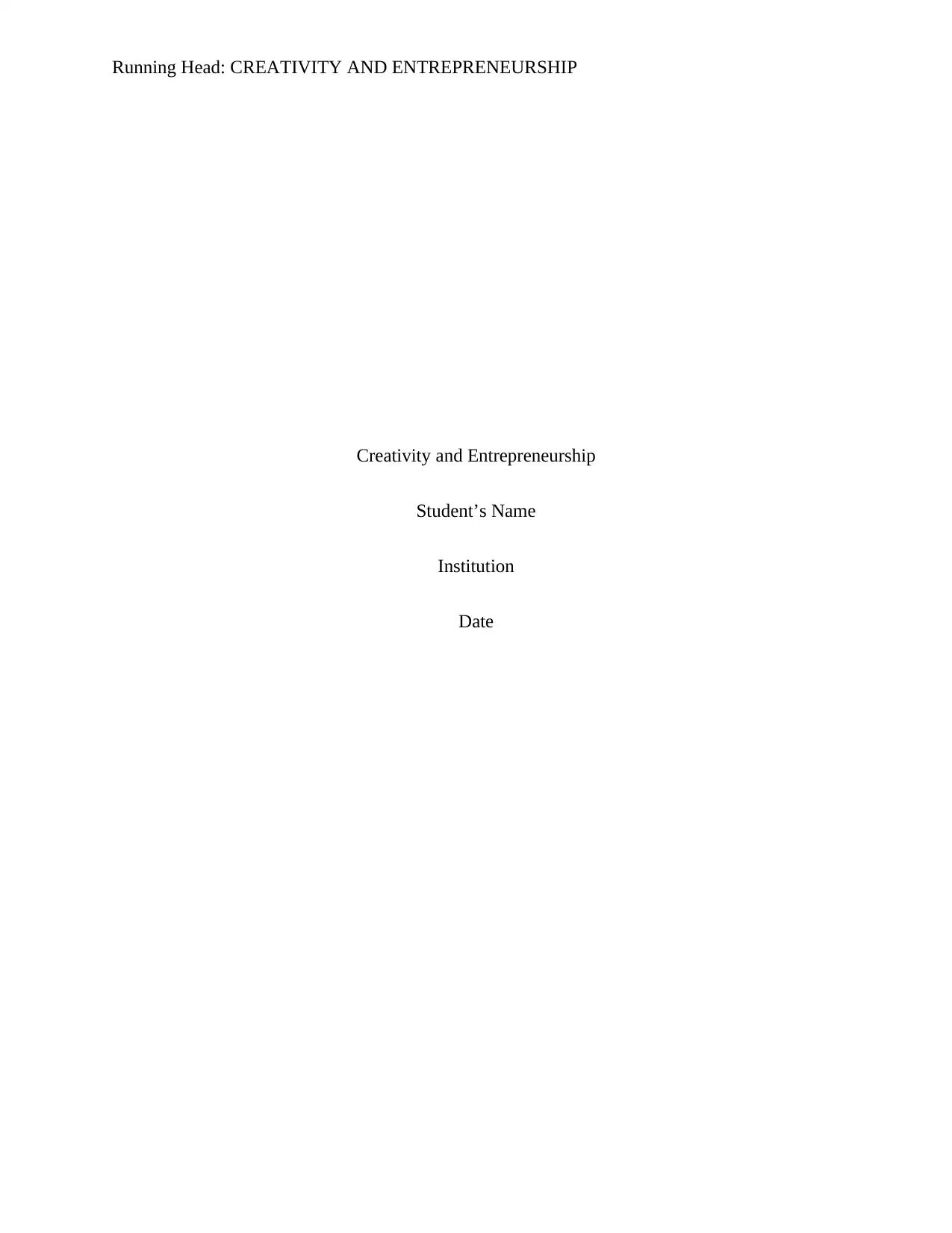
Running Head: CREATIVITY AND ENTREPRENEURSHIP
Creativity and Entrepreneurship
Student’s Name
Institution
Date
Creativity and Entrepreneurship
Student’s Name
Institution
Date
Paraphrase This Document
Need a fresh take? Get an instant paraphrase of this document with our AI Paraphraser
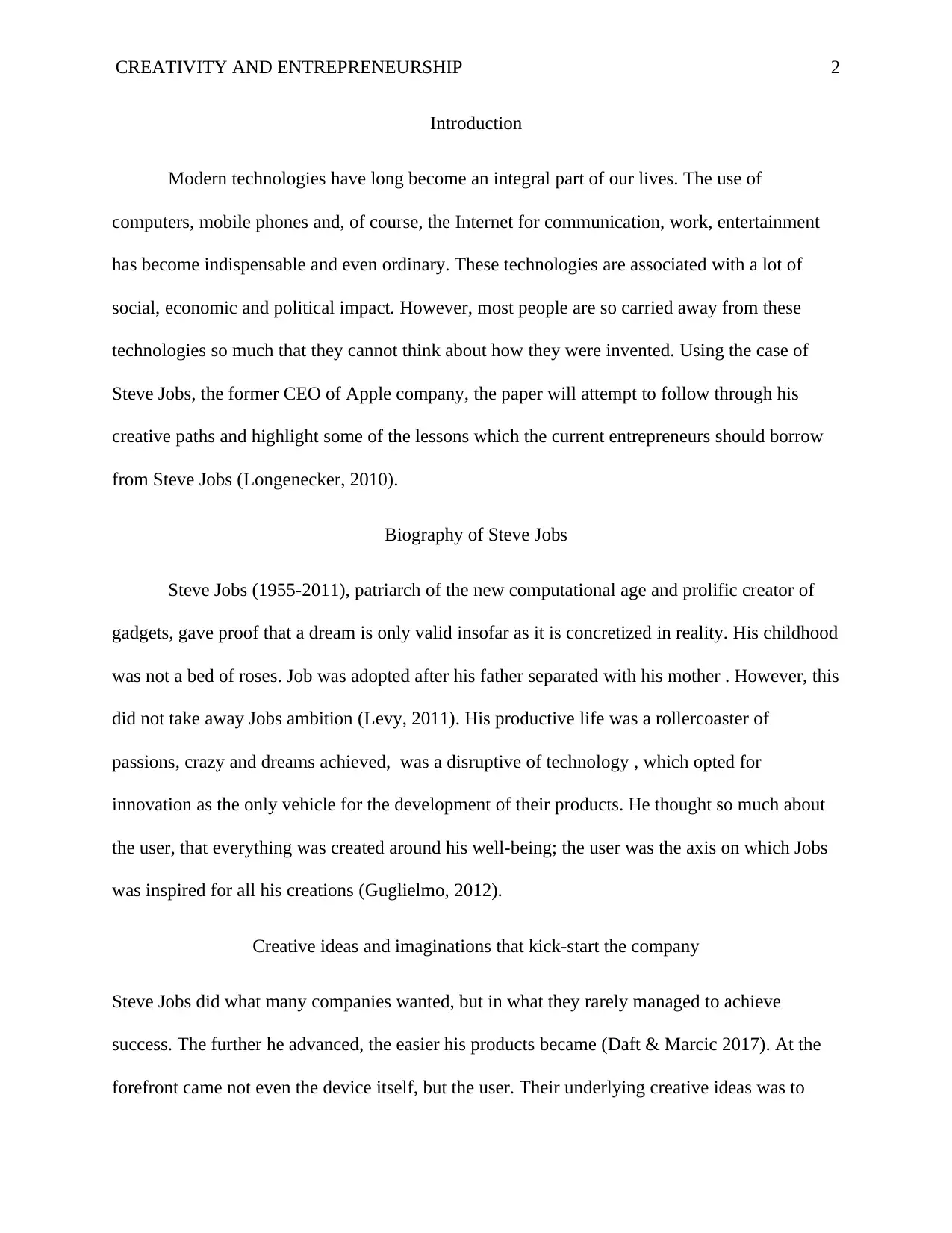
CREATIVITY AND ENTREPRENEURSHIP 2
Introduction
Modern technologies have long become an integral part of our lives. The use of
computers, mobile phones and, of course, the Internet for communication, work, entertainment
has become indispensable and even ordinary. These technologies are associated with a lot of
social, economic and political impact. However, most people are so carried away from these
technologies so much that they cannot think about how they were invented. Using the case of
Steve Jobs, the former CEO of Apple company, the paper will attempt to follow through his
creative paths and highlight some of the lessons which the current entrepreneurs should borrow
from Steve Jobs (Longenecker, 2010).
Biography of Steve Jobs
Steve Jobs (1955-2011), patriarch of the new computational age and prolific creator of
gadgets, gave proof that a dream is only valid insofar as it is concretized in reality. His childhood
was not a bed of roses. Job was adopted after his father separated with his mother . However, this
did not take away Jobs ambition (Levy, 2011). His productive life was a rollercoaster of
passions, crazy and dreams achieved, was a disruptive of technology , which opted for
innovation as the only vehicle for the development of their products. He thought so much about
the user, that everything was created around his well-being; the user was the axis on which Jobs
was inspired for all his creations (Guglielmo, 2012).
Creative ideas and imaginations that kick-start the company
Steve Jobs did what many companies wanted, but in what they rarely managed to achieve
success. The further he advanced, the easier his products became (Daft & Marcic 2017). At the
forefront came not even the device itself, but the user. Their underlying creative ideas was to
Introduction
Modern technologies have long become an integral part of our lives. The use of
computers, mobile phones and, of course, the Internet for communication, work, entertainment
has become indispensable and even ordinary. These technologies are associated with a lot of
social, economic and political impact. However, most people are so carried away from these
technologies so much that they cannot think about how they were invented. Using the case of
Steve Jobs, the former CEO of Apple company, the paper will attempt to follow through his
creative paths and highlight some of the lessons which the current entrepreneurs should borrow
from Steve Jobs (Longenecker, 2010).
Biography of Steve Jobs
Steve Jobs (1955-2011), patriarch of the new computational age and prolific creator of
gadgets, gave proof that a dream is only valid insofar as it is concretized in reality. His childhood
was not a bed of roses. Job was adopted after his father separated with his mother . However, this
did not take away Jobs ambition (Levy, 2011). His productive life was a rollercoaster of
passions, crazy and dreams achieved, was a disruptive of technology , which opted for
innovation as the only vehicle for the development of their products. He thought so much about
the user, that everything was created around his well-being; the user was the axis on which Jobs
was inspired for all his creations (Guglielmo, 2012).
Creative ideas and imaginations that kick-start the company
Steve Jobs did what many companies wanted, but in what they rarely managed to achieve
success. The further he advanced, the easier his products became (Daft & Marcic 2017). At the
forefront came not even the device itself, but the user. Their underlying creative ideas was to
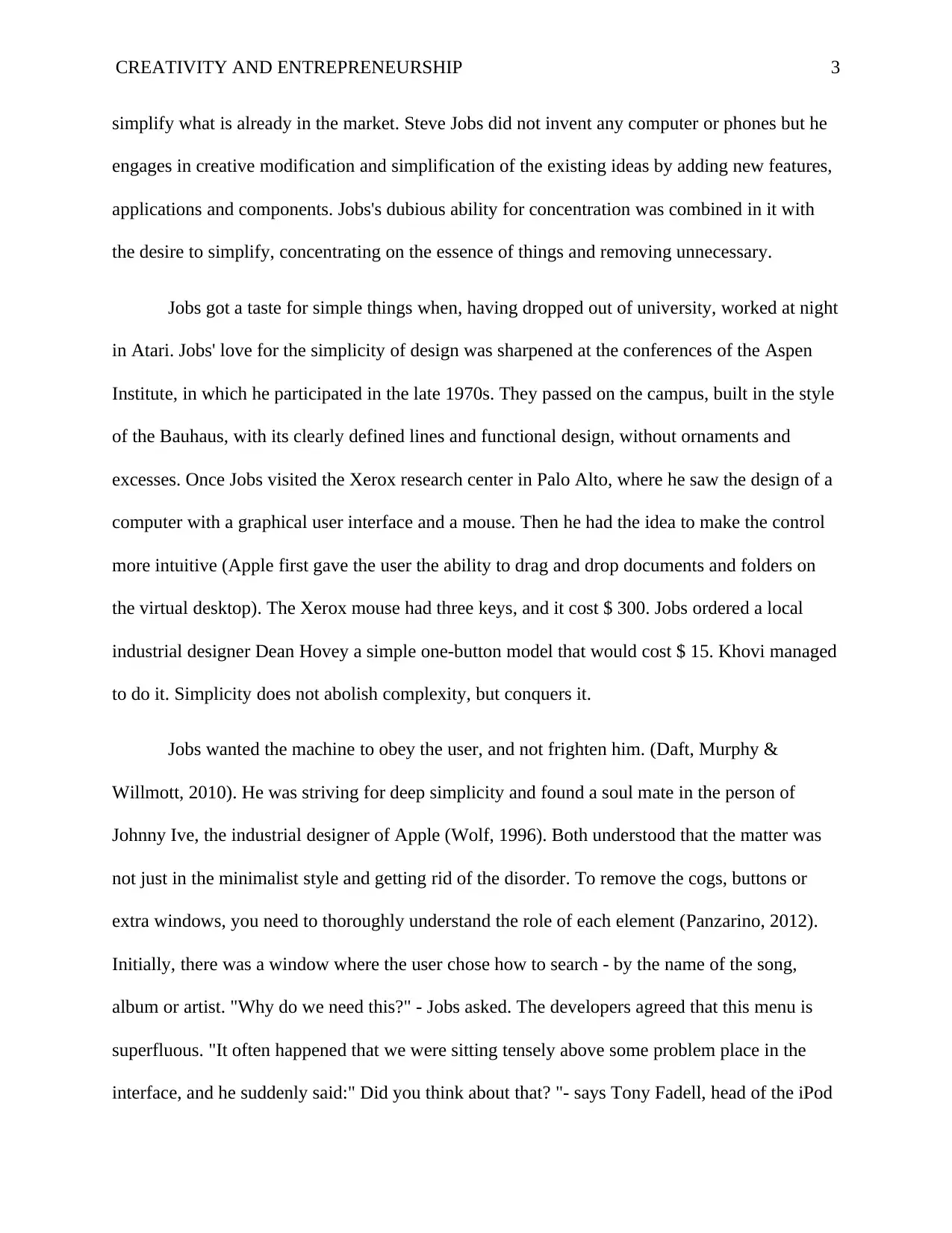
CREATIVITY AND ENTREPRENEURSHIP 3
simplify what is already in the market. Steve Jobs did not invent any computer or phones but he
engages in creative modification and simplification of the existing ideas by adding new features,
applications and components. Jobs's dubious ability for concentration was combined in it with
the desire to simplify, concentrating on the essence of things and removing unnecessary.
Jobs got a taste for simple things when, having dropped out of university, worked at night
in Atari. Jobs' love for the simplicity of design was sharpened at the conferences of the Aspen
Institute, in which he participated in the late 1970s. They passed on the campus, built in the style
of the Bauhaus, with its clearly defined lines and functional design, without ornaments and
excesses. Once Jobs visited the Xerox research center in Palo Alto, where he saw the design of a
computer with a graphical user interface and a mouse. Then he had the idea to make the control
more intuitive (Apple first gave the user the ability to drag and drop documents and folders on
the virtual desktop). The Xerox mouse had three keys, and it cost $ 300. Jobs ordered a local
industrial designer Dean Hovey a simple one-button model that would cost $ 15. Khovi managed
to do it. Simplicity does not abolish complexity, but conquers it.
Jobs wanted the machine to obey the user, and not frighten him. (Daft, Murphy &
Willmott, 2010). He was striving for deep simplicity and found a soul mate in the person of
Johnny Ive, the industrial designer of Apple (Wolf, 1996). Both understood that the matter was
not just in the minimalist style and getting rid of the disorder. To remove the cogs, buttons or
extra windows, you need to thoroughly understand the role of each element (Panzarino, 2012).
Initially, there was a window where the user chose how to search - by the name of the song,
album or artist. "Why do we need this?" - Jobs asked. The developers agreed that this menu is
superfluous. "It often happened that we were sitting tensely above some problem place in the
interface, and he suddenly said:" Did you think about that? "- says Tony Fadell, head of the iPod
simplify what is already in the market. Steve Jobs did not invent any computer or phones but he
engages in creative modification and simplification of the existing ideas by adding new features,
applications and components. Jobs's dubious ability for concentration was combined in it with
the desire to simplify, concentrating on the essence of things and removing unnecessary.
Jobs got a taste for simple things when, having dropped out of university, worked at night
in Atari. Jobs' love for the simplicity of design was sharpened at the conferences of the Aspen
Institute, in which he participated in the late 1970s. They passed on the campus, built in the style
of the Bauhaus, with its clearly defined lines and functional design, without ornaments and
excesses. Once Jobs visited the Xerox research center in Palo Alto, where he saw the design of a
computer with a graphical user interface and a mouse. Then he had the idea to make the control
more intuitive (Apple first gave the user the ability to drag and drop documents and folders on
the virtual desktop). The Xerox mouse had three keys, and it cost $ 300. Jobs ordered a local
industrial designer Dean Hovey a simple one-button model that would cost $ 15. Khovi managed
to do it. Simplicity does not abolish complexity, but conquers it.
Jobs wanted the machine to obey the user, and not frighten him. (Daft, Murphy &
Willmott, 2010). He was striving for deep simplicity and found a soul mate in the person of
Johnny Ive, the industrial designer of Apple (Wolf, 1996). Both understood that the matter was
not just in the minimalist style and getting rid of the disorder. To remove the cogs, buttons or
extra windows, you need to thoroughly understand the role of each element (Panzarino, 2012).
Initially, there was a window where the user chose how to search - by the name of the song,
album or artist. "Why do we need this?" - Jobs asked. The developers agreed that this menu is
superfluous. "It often happened that we were sitting tensely above some problem place in the
interface, and he suddenly said:" Did you think about that? "- says Tony Fadell, head of the iPod
⊘ This is a preview!⊘
Do you want full access?
Subscribe today to unlock all pages.

Trusted by 1+ million students worldwide
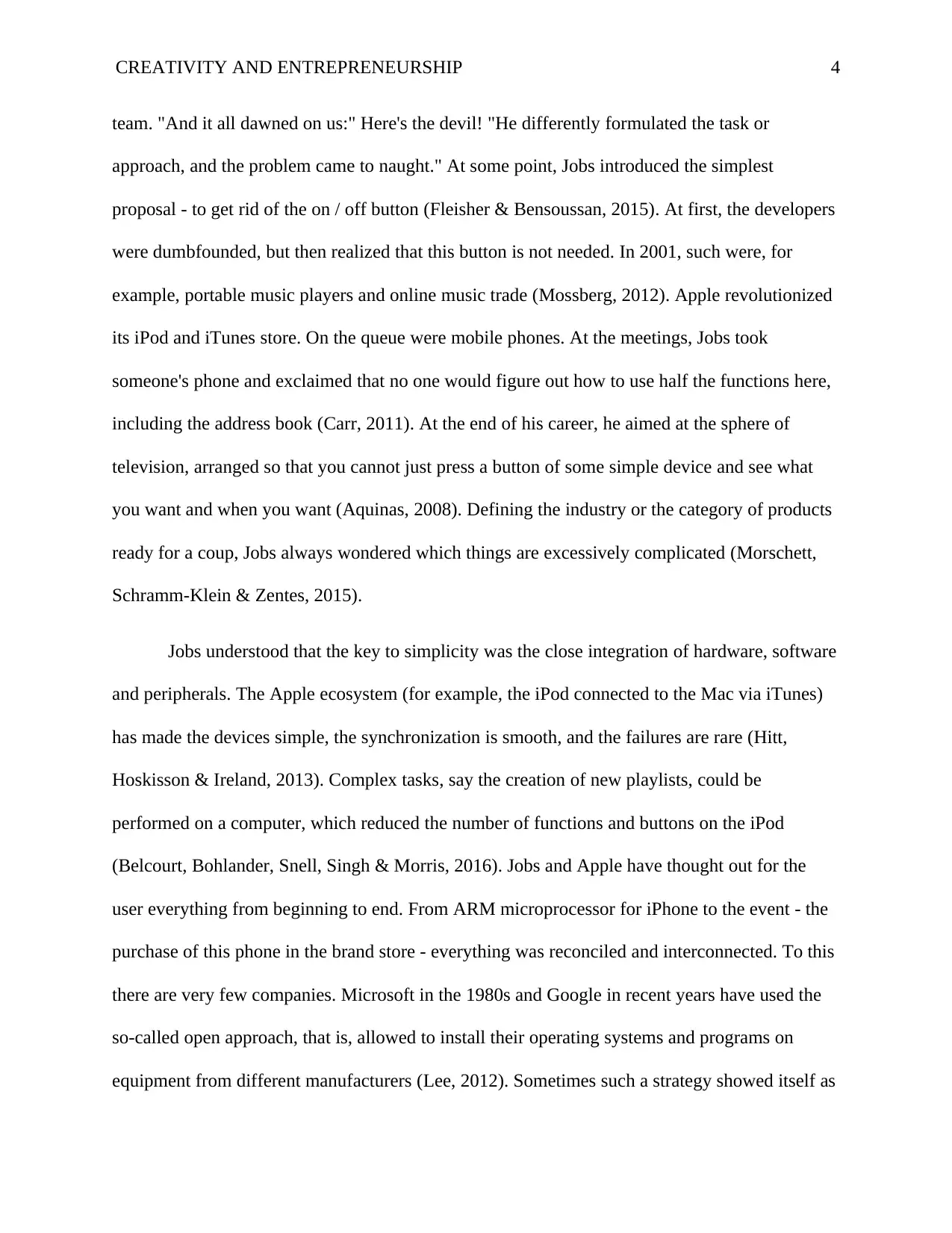
CREATIVITY AND ENTREPRENEURSHIP 4
team. "And it all dawned on us:" Here's the devil! "He differently formulated the task or
approach, and the problem came to naught." At some point, Jobs introduced the simplest
proposal - to get rid of the on / off button (Fleisher & Bensoussan, 2015). At first, the developers
were dumbfounded, but then realized that this button is not needed. In 2001, such were, for
example, portable music players and online music trade (Mossberg, 2012). Apple revolutionized
its iPod and iTunes store. On the queue were mobile phones. At the meetings, Jobs took
someone's phone and exclaimed that no one would figure out how to use half the functions here,
including the address book (Carr, 2011). At the end of his career, he aimed at the sphere of
television, arranged so that you cannot just press a button of some simple device and see what
you want and when you want (Aquinas, 2008). Defining the industry or the category of products
ready for a coup, Jobs always wondered which things are excessively complicated (Morschett,
Schramm-Klein & Zentes, 2015).
Jobs understood that the key to simplicity was the close integration of hardware, software
and peripherals. The Apple ecosystem (for example, the iPod connected to the Mac via iTunes)
has made the devices simple, the synchronization is smooth, and the failures are rare (Hitt,
Hoskisson & Ireland, 2013). Complex tasks, say the creation of new playlists, could be
performed on a computer, which reduced the number of functions and buttons on the iPod
(Belcourt, Bohlander, Snell, Singh & Morris, 2016). Jobs and Apple have thought out for the
user everything from beginning to end. From ARM microprocessor for iPhone to the event - the
purchase of this phone in the brand store - everything was reconciled and interconnected. To this
there are very few companies. Microsoft in the 1980s and Google in recent years have used the
so-called open approach, that is, allowed to install their operating systems and programs on
equipment from different manufacturers (Lee, 2012). Sometimes such a strategy showed itself as
team. "And it all dawned on us:" Here's the devil! "He differently formulated the task or
approach, and the problem came to naught." At some point, Jobs introduced the simplest
proposal - to get rid of the on / off button (Fleisher & Bensoussan, 2015). At first, the developers
were dumbfounded, but then realized that this button is not needed. In 2001, such were, for
example, portable music players and online music trade (Mossberg, 2012). Apple revolutionized
its iPod and iTunes store. On the queue were mobile phones. At the meetings, Jobs took
someone's phone and exclaimed that no one would figure out how to use half the functions here,
including the address book (Carr, 2011). At the end of his career, he aimed at the sphere of
television, arranged so that you cannot just press a button of some simple device and see what
you want and when you want (Aquinas, 2008). Defining the industry or the category of products
ready for a coup, Jobs always wondered which things are excessively complicated (Morschett,
Schramm-Klein & Zentes, 2015).
Jobs understood that the key to simplicity was the close integration of hardware, software
and peripherals. The Apple ecosystem (for example, the iPod connected to the Mac via iTunes)
has made the devices simple, the synchronization is smooth, and the failures are rare (Hitt,
Hoskisson & Ireland, 2013). Complex tasks, say the creation of new playlists, could be
performed on a computer, which reduced the number of functions and buttons on the iPod
(Belcourt, Bohlander, Snell, Singh & Morris, 2016). Jobs and Apple have thought out for the
user everything from beginning to end. From ARM microprocessor for iPhone to the event - the
purchase of this phone in the brand store - everything was reconciled and interconnected. To this
there are very few companies. Microsoft in the 1980s and Google in recent years have used the
so-called open approach, that is, allowed to install their operating systems and programs on
equipment from different manufacturers (Lee, 2012). Sometimes such a strategy showed itself as
Paraphrase This Document
Need a fresh take? Get an instant paraphrase of this document with our AI Paraphraser
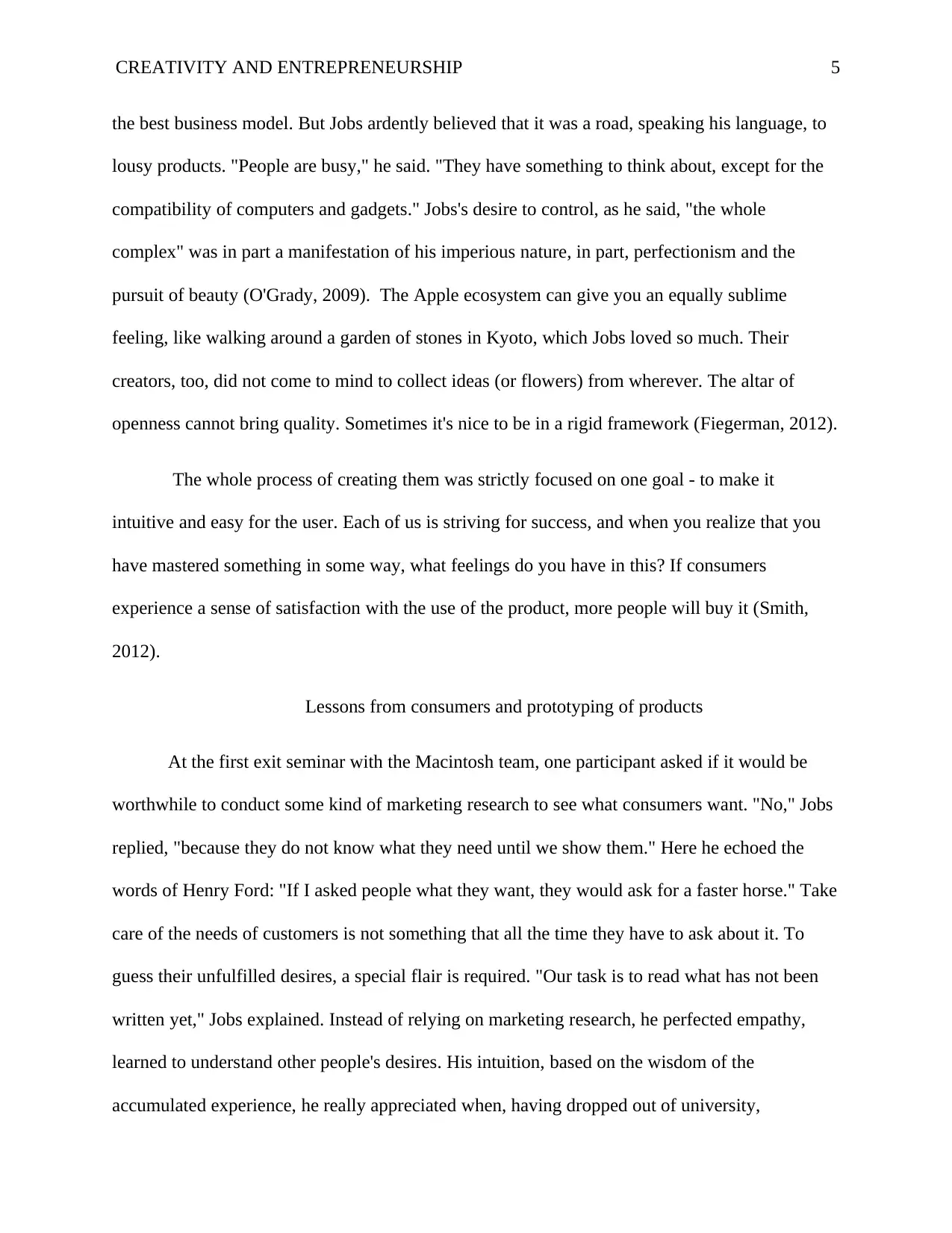
CREATIVITY AND ENTREPRENEURSHIP 5
the best business model. But Jobs ardently believed that it was a road, speaking his language, to
lousy products. "People are busy," he said. "They have something to think about, except for the
compatibility of computers and gadgets." Jobs's desire to control, as he said, "the whole
complex" was in part a manifestation of his imperious nature, in part, perfectionism and the
pursuit of beauty (O'Grady, 2009). The Apple ecosystem can give you an equally sublime
feeling, like walking around a garden of stones in Kyoto, which Jobs loved so much. Their
creators, too, did not come to mind to collect ideas (or flowers) from wherever. The altar of
openness cannot bring quality. Sometimes it's nice to be in a rigid framework (Fiegerman, 2012).
The whole process of creating them was strictly focused on one goal - to make it
intuitive and easy for the user. Each of us is striving for success, and when you realize that you
have mastered something in some way, what feelings do you have in this? If consumers
experience a sense of satisfaction with the use of the product, more people will buy it (Smith,
2012).
Lessons from consumers and prototyping of products
At the first exit seminar with the Macintosh team, one participant asked if it would be
worthwhile to conduct some kind of marketing research to see what consumers want. "No," Jobs
replied, "because they do not know what they need until we show them." Here he echoed the
words of Henry Ford: "If I asked people what they want, they would ask for a faster horse." Take
care of the needs of customers is not something that all the time they have to ask about it. To
guess their unfulfilled desires, a special flair is required. "Our task is to read what has not been
written yet," Jobs explained. Instead of relying on marketing research, he perfected empathy,
learned to understand other people's desires. His intuition, based on the wisdom of the
accumulated experience, he really appreciated when, having dropped out of university,
the best business model. But Jobs ardently believed that it was a road, speaking his language, to
lousy products. "People are busy," he said. "They have something to think about, except for the
compatibility of computers and gadgets." Jobs's desire to control, as he said, "the whole
complex" was in part a manifestation of his imperious nature, in part, perfectionism and the
pursuit of beauty (O'Grady, 2009). The Apple ecosystem can give you an equally sublime
feeling, like walking around a garden of stones in Kyoto, which Jobs loved so much. Their
creators, too, did not come to mind to collect ideas (or flowers) from wherever. The altar of
openness cannot bring quality. Sometimes it's nice to be in a rigid framework (Fiegerman, 2012).
The whole process of creating them was strictly focused on one goal - to make it
intuitive and easy for the user. Each of us is striving for success, and when you realize that you
have mastered something in some way, what feelings do you have in this? If consumers
experience a sense of satisfaction with the use of the product, more people will buy it (Smith,
2012).
Lessons from consumers and prototyping of products
At the first exit seminar with the Macintosh team, one participant asked if it would be
worthwhile to conduct some kind of marketing research to see what consumers want. "No," Jobs
replied, "because they do not know what they need until we show them." Here he echoed the
words of Henry Ford: "If I asked people what they want, they would ask for a faster horse." Take
care of the needs of customers is not something that all the time they have to ask about it. To
guess their unfulfilled desires, a special flair is required. "Our task is to read what has not been
written yet," Jobs explained. Instead of relying on marketing research, he perfected empathy,
learned to understand other people's desires. His intuition, based on the wisdom of the
accumulated experience, he really appreciated when, having dropped out of university,
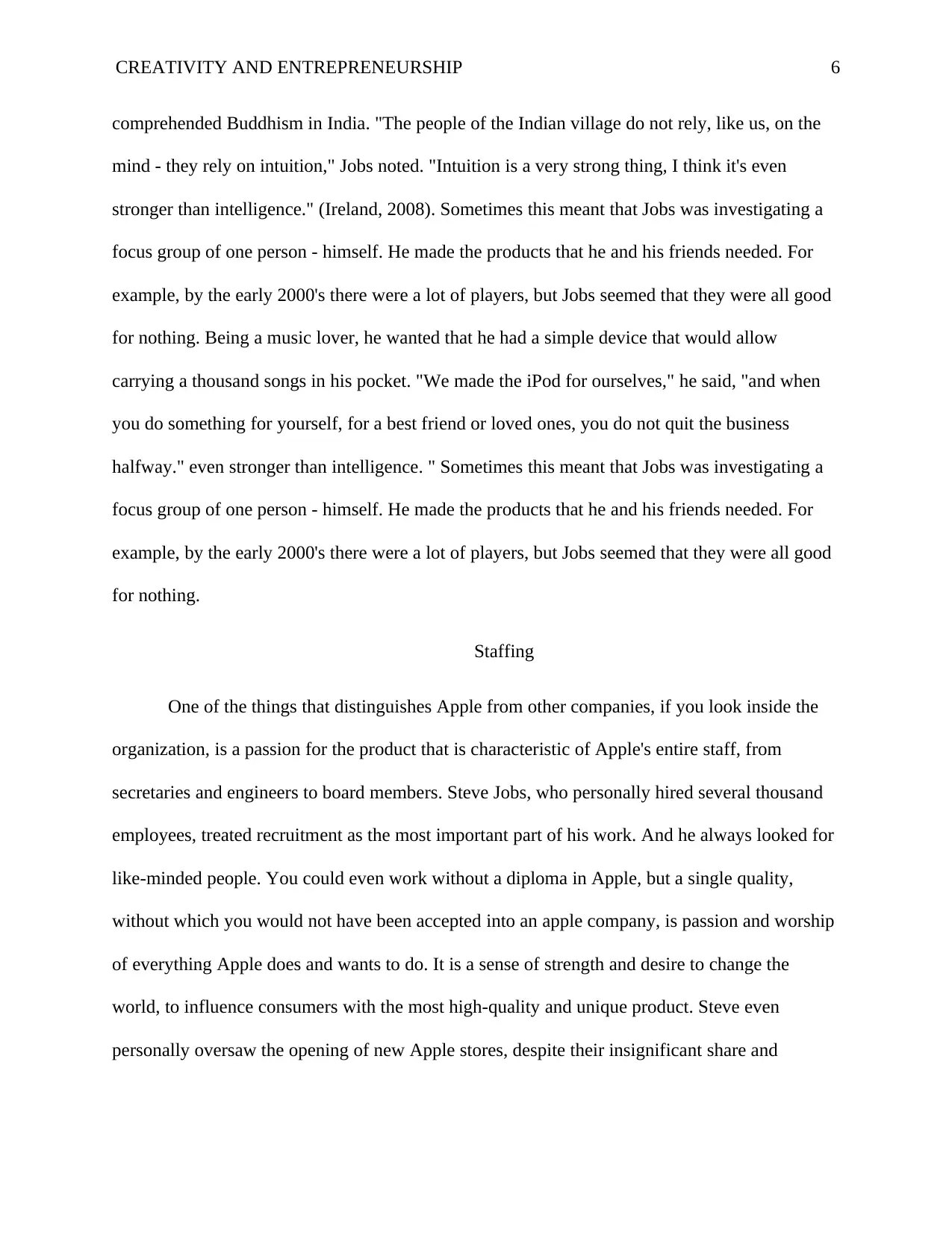
CREATIVITY AND ENTREPRENEURSHIP 6
comprehended Buddhism in India. "The people of the Indian village do not rely, like us, on the
mind - they rely on intuition," Jobs noted. "Intuition is a very strong thing, I think it's even
stronger than intelligence." (Ireland, 2008). Sometimes this meant that Jobs was investigating a
focus group of one person - himself. He made the products that he and his friends needed. For
example, by the early 2000's there were a lot of players, but Jobs seemed that they were all good
for nothing. Being a music lover, he wanted that he had a simple device that would allow
carrying a thousand songs in his pocket. "We made the iPod for ourselves," he said, "and when
you do something for yourself, for a best friend or loved ones, you do not quit the business
halfway." even stronger than intelligence. " Sometimes this meant that Jobs was investigating a
focus group of one person - himself. He made the products that he and his friends needed. For
example, by the early 2000's there were a lot of players, but Jobs seemed that they were all good
for nothing.
Staffing
One of the things that distinguishes Apple from other companies, if you look inside the
organization, is a passion for the product that is characteristic of Apple's entire staff, from
secretaries and engineers to board members. Steve Jobs, who personally hired several thousand
employees, treated recruitment as the most important part of his work. And he always looked for
like-minded people. You could even work without a diploma in Apple, but a single quality,
without which you would not have been accepted into an apple company, is passion and worship
of everything Apple does and wants to do. It is a sense of strength and desire to change the
world, to influence consumers with the most high-quality and unique product. Steve even
personally oversaw the opening of new Apple stores, despite their insignificant share and
comprehended Buddhism in India. "The people of the Indian village do not rely, like us, on the
mind - they rely on intuition," Jobs noted. "Intuition is a very strong thing, I think it's even
stronger than intelligence." (Ireland, 2008). Sometimes this meant that Jobs was investigating a
focus group of one person - himself. He made the products that he and his friends needed. For
example, by the early 2000's there were a lot of players, but Jobs seemed that they were all good
for nothing. Being a music lover, he wanted that he had a simple device that would allow
carrying a thousand songs in his pocket. "We made the iPod for ourselves," he said, "and when
you do something for yourself, for a best friend or loved ones, you do not quit the business
halfway." even stronger than intelligence. " Sometimes this meant that Jobs was investigating a
focus group of one person - himself. He made the products that he and his friends needed. For
example, by the early 2000's there were a lot of players, but Jobs seemed that they were all good
for nothing.
Staffing
One of the things that distinguishes Apple from other companies, if you look inside the
organization, is a passion for the product that is characteristic of Apple's entire staff, from
secretaries and engineers to board members. Steve Jobs, who personally hired several thousand
employees, treated recruitment as the most important part of his work. And he always looked for
like-minded people. You could even work without a diploma in Apple, but a single quality,
without which you would not have been accepted into an apple company, is passion and worship
of everything Apple does and wants to do. It is a sense of strength and desire to change the
world, to influence consumers with the most high-quality and unique product. Steve even
personally oversaw the opening of new Apple stores, despite their insignificant share and
⊘ This is a preview!⊘
Do you want full access?
Subscribe today to unlock all pages.

Trusted by 1+ million students worldwide
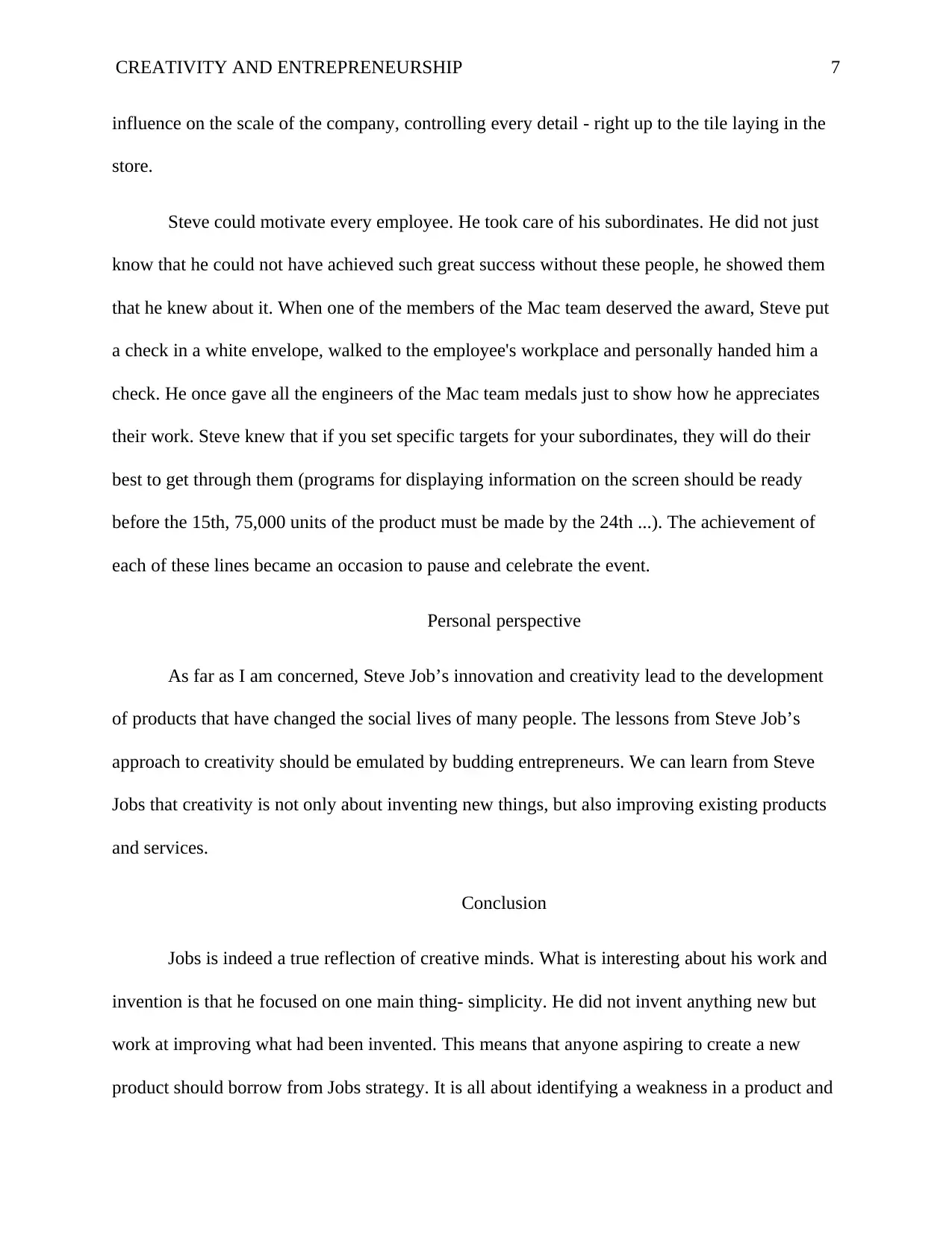
CREATIVITY AND ENTREPRENEURSHIP 7
influence on the scale of the company, controlling every detail - right up to the tile laying in the
store.
Steve could motivate every employee. He took care of his subordinates. He did not just
know that he could not have achieved such great success without these people, he showed them
that he knew about it. When one of the members of the Mac team deserved the award, Steve put
a check in a white envelope, walked to the employee's workplace and personally handed him a
check. He once gave all the engineers of the Mac team medals just to show how he appreciates
their work. Steve knew that if you set specific targets for your subordinates, they will do their
best to get through them (programs for displaying information on the screen should be ready
before the 15th, 75,000 units of the product must be made by the 24th ...). The achievement of
each of these lines became an occasion to pause and celebrate the event.
Personal perspective
As far as I am concerned, Steve Job’s innovation and creativity lead to the development
of products that have changed the social lives of many people. The lessons from Steve Job’s
approach to creativity should be emulated by budding entrepreneurs. We can learn from Steve
Jobs that creativity is not only about inventing new things, but also improving existing products
and services.
Conclusion
Jobs is indeed a true reflection of creative minds. What is interesting about his work and
invention is that he focused on one main thing- simplicity. He did not invent anything new but
work at improving what had been invented. This means that anyone aspiring to create a new
product should borrow from Jobs strategy. It is all about identifying a weakness in a product and
influence on the scale of the company, controlling every detail - right up to the tile laying in the
store.
Steve could motivate every employee. He took care of his subordinates. He did not just
know that he could not have achieved such great success without these people, he showed them
that he knew about it. When one of the members of the Mac team deserved the award, Steve put
a check in a white envelope, walked to the employee's workplace and personally handed him a
check. He once gave all the engineers of the Mac team medals just to show how he appreciates
their work. Steve knew that if you set specific targets for your subordinates, they will do their
best to get through them (programs for displaying information on the screen should be ready
before the 15th, 75,000 units of the product must be made by the 24th ...). The achievement of
each of these lines became an occasion to pause and celebrate the event.
Personal perspective
As far as I am concerned, Steve Job’s innovation and creativity lead to the development
of products that have changed the social lives of many people. The lessons from Steve Job’s
approach to creativity should be emulated by budding entrepreneurs. We can learn from Steve
Jobs that creativity is not only about inventing new things, but also improving existing products
and services.
Conclusion
Jobs is indeed a true reflection of creative minds. What is interesting about his work and
invention is that he focused on one main thing- simplicity. He did not invent anything new but
work at improving what had been invented. This means that anyone aspiring to create a new
product should borrow from Jobs strategy. It is all about identifying a weakness in a product and
Paraphrase This Document
Need a fresh take? Get an instant paraphrase of this document with our AI Paraphraser
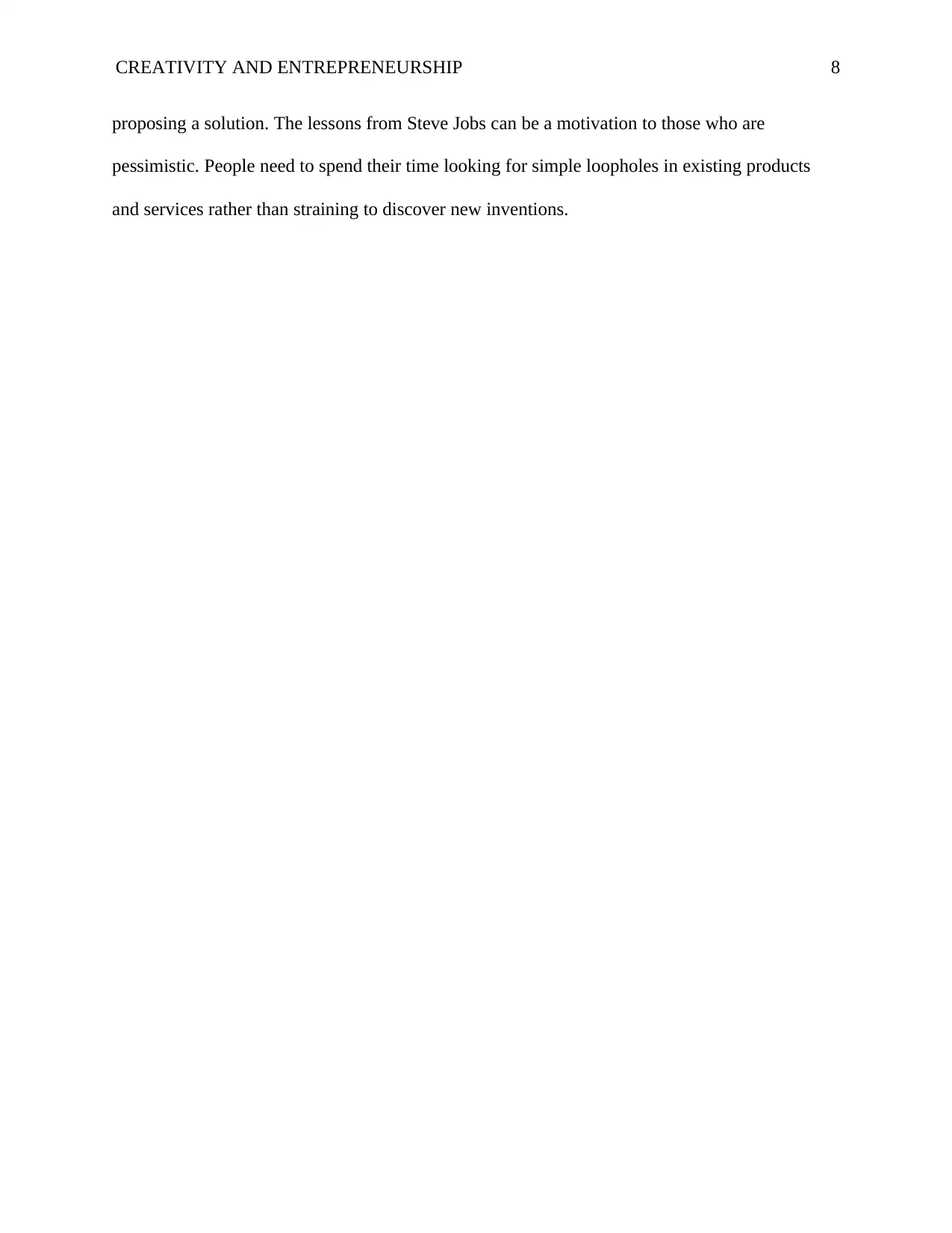
CREATIVITY AND ENTREPRENEURSHIP 8
proposing a solution. The lessons from Steve Jobs can be a motivation to those who are
pessimistic. People need to spend their time looking for simple loopholes in existing products
and services rather than straining to discover new inventions.
proposing a solution. The lessons from Steve Jobs can be a motivation to those who are
pessimistic. People need to spend their time looking for simple loopholes in existing products
and services rather than straining to discover new inventions.
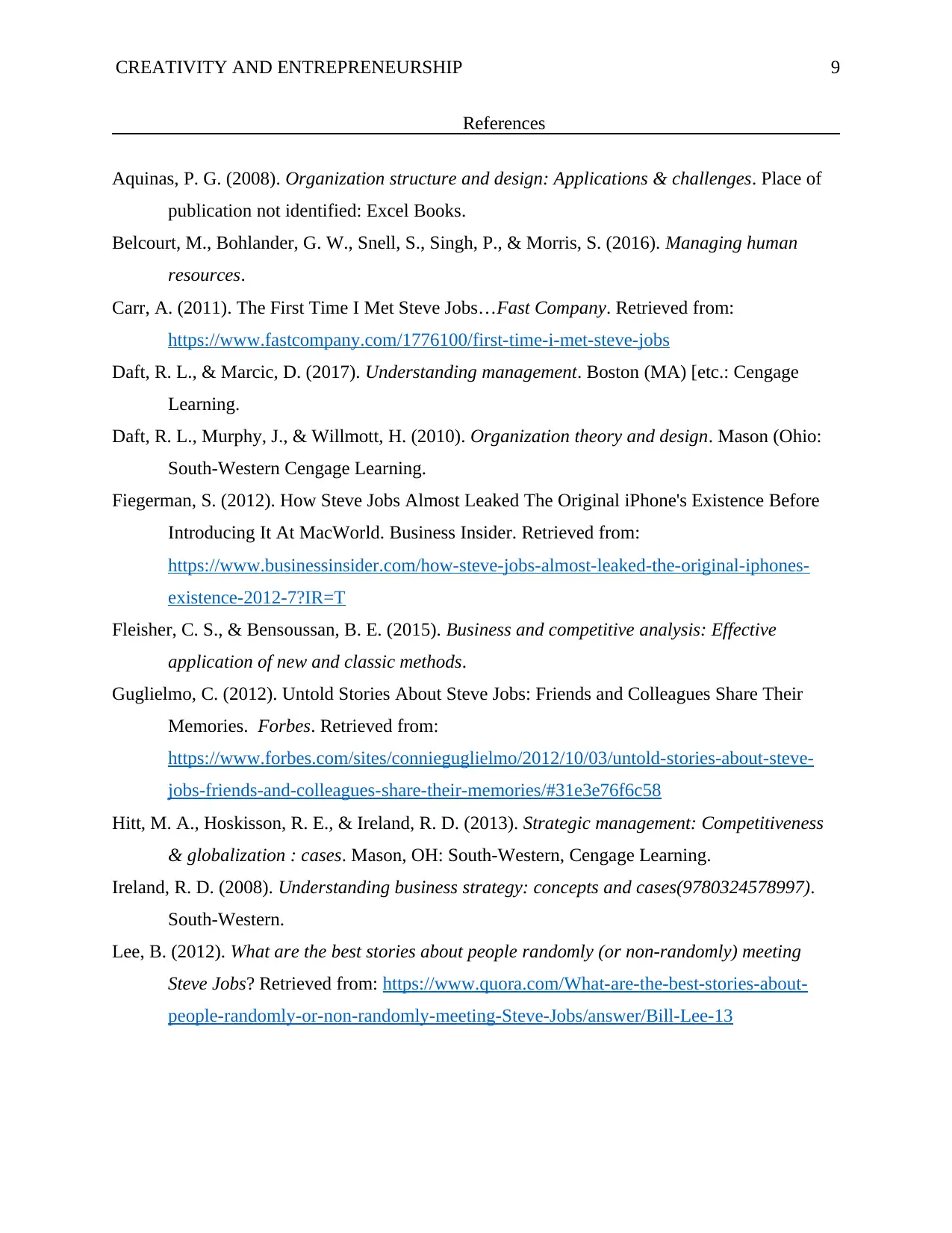
CREATIVITY AND ENTREPRENEURSHIP 9
References
Aquinas, P. G. (2008). Organization structure and design: Applications & challenges. Place of
publication not identified: Excel Books.
Belcourt, M., Bohlander, G. W., Snell, S., Singh, P., & Morris, S. (2016). Managing human
resources.
Carr, A. (2011). The First Time I Met Steve Jobs…Fast Company. Retrieved from:
https://www.fastcompany.com/1776100/first-time-i-met-steve-jobs
Daft, R. L., & Marcic, D. (2017). Understanding management. Boston (MA) [etc.: Cengage
Learning.
Daft, R. L., Murphy, J., & Willmott, H. (2010). Organization theory and design. Mason (Ohio:
South-Western Cengage Learning.
Fiegerman, S. (2012). How Steve Jobs Almost Leaked The Original iPhone's Existence Before
Introducing It At MacWorld. Business Insider. Retrieved from:
https://www.businessinsider.com/how-steve-jobs-almost-leaked-the-original-iphones-
existence-2012-7?IR=T
Fleisher, C. S., & Bensoussan, B. E. (2015). Business and competitive analysis: Effective
application of new and classic methods.
Guglielmo, C. (2012). Untold Stories About Steve Jobs: Friends and Colleagues Share Their
Memories. Forbes. Retrieved from:
https://www.forbes.com/sites/connieguglielmo/2012/10/03/untold-stories-about-steve-
jobs-friends-and-colleagues-share-their-memories/#31e3e76f6c58
Hitt, M. A., Hoskisson, R. E., & Ireland, R. D. (2013). Strategic management: Competitiveness
& globalization : cases. Mason, OH: South-Western, Cengage Learning.
Ireland, R. D. (2008). Understanding business strategy: concepts and cases(9780324578997).
South-Western.
Lee, B. (2012). What are the best stories about people randomly (or non-randomly) meeting
Steve Jobs? Retrieved from: https://www.quora.com/What-are-the-best-stories-about-
people-randomly-or-non-randomly-meeting-Steve-Jobs/answer/Bill-Lee-13
References
Aquinas, P. G. (2008). Organization structure and design: Applications & challenges. Place of
publication not identified: Excel Books.
Belcourt, M., Bohlander, G. W., Snell, S., Singh, P., & Morris, S. (2016). Managing human
resources.
Carr, A. (2011). The First Time I Met Steve Jobs…Fast Company. Retrieved from:
https://www.fastcompany.com/1776100/first-time-i-met-steve-jobs
Daft, R. L., & Marcic, D. (2017). Understanding management. Boston (MA) [etc.: Cengage
Learning.
Daft, R. L., Murphy, J., & Willmott, H. (2010). Organization theory and design. Mason (Ohio:
South-Western Cengage Learning.
Fiegerman, S. (2012). How Steve Jobs Almost Leaked The Original iPhone's Existence Before
Introducing It At MacWorld. Business Insider. Retrieved from:
https://www.businessinsider.com/how-steve-jobs-almost-leaked-the-original-iphones-
existence-2012-7?IR=T
Fleisher, C. S., & Bensoussan, B. E. (2015). Business and competitive analysis: Effective
application of new and classic methods.
Guglielmo, C. (2012). Untold Stories About Steve Jobs: Friends and Colleagues Share Their
Memories. Forbes. Retrieved from:
https://www.forbes.com/sites/connieguglielmo/2012/10/03/untold-stories-about-steve-
jobs-friends-and-colleagues-share-their-memories/#31e3e76f6c58
Hitt, M. A., Hoskisson, R. E., & Ireland, R. D. (2013). Strategic management: Competitiveness
& globalization : cases. Mason, OH: South-Western, Cengage Learning.
Ireland, R. D. (2008). Understanding business strategy: concepts and cases(9780324578997).
South-Western.
Lee, B. (2012). What are the best stories about people randomly (or non-randomly) meeting
Steve Jobs? Retrieved from: https://www.quora.com/What-are-the-best-stories-about-
people-randomly-or-non-randomly-meeting-Steve-Jobs/answer/Bill-Lee-13
⊘ This is a preview!⊘
Do you want full access?
Subscribe today to unlock all pages.

Trusted by 1+ million students worldwide
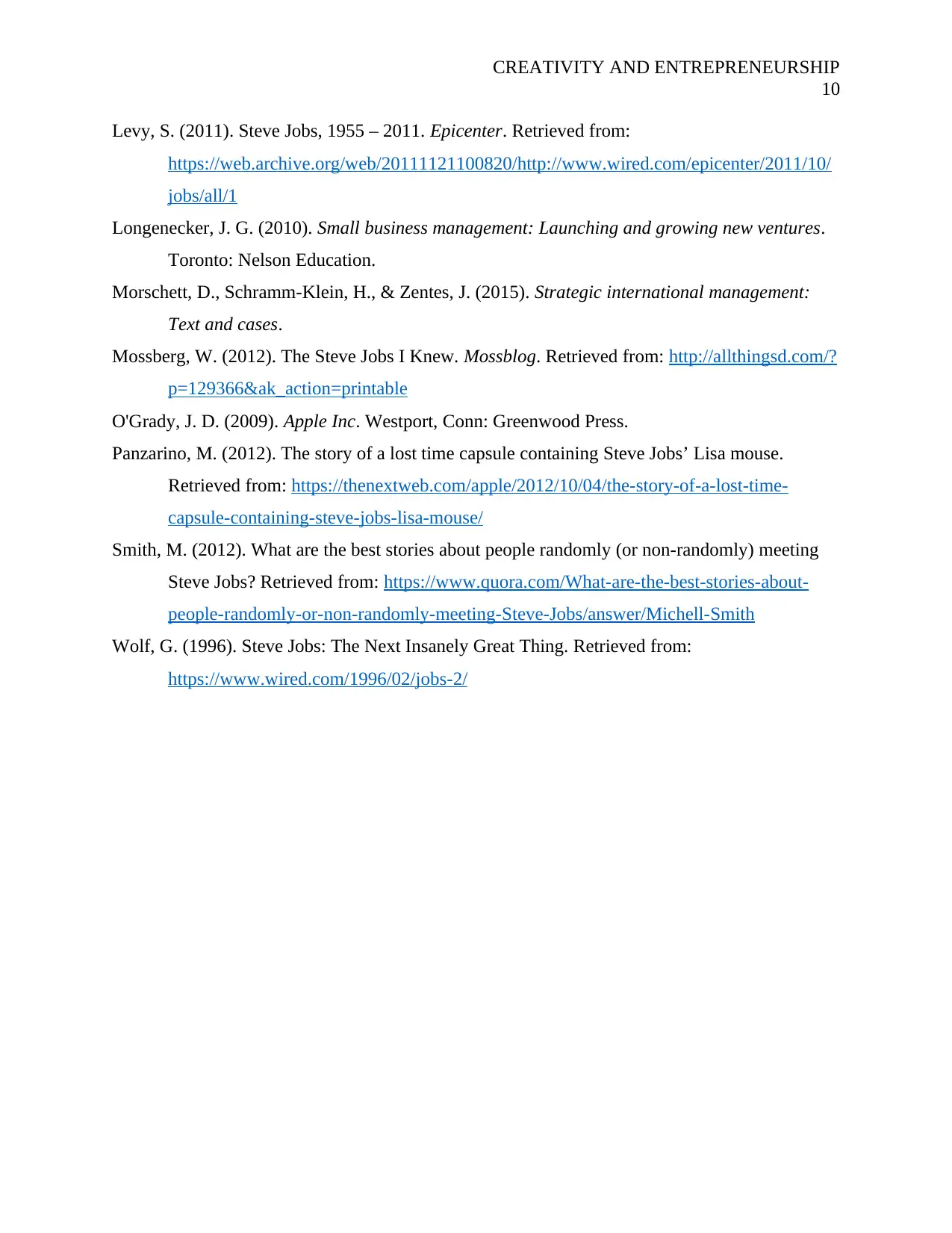
CREATIVITY AND ENTREPRENEURSHIP
10
Levy, S. (2011). Steve Jobs, 1955 – 2011. Epicenter. Retrieved from:
https://web.archive.org/web/20111121100820/http://www.wired.com/epicenter/2011/10/
jobs/all/1
Longenecker, J. G. (2010). Small business management: Launching and growing new ventures.
Toronto: Nelson Education.
Morschett, D., Schramm-Klein, H., & Zentes, J. (2015). Strategic international management:
Text and cases.
Mossberg, W. (2012). The Steve Jobs I Knew. Mossblog. Retrieved from: http://allthingsd.com/?
p=129366&ak_action=printable
O'Grady, J. D. (2009). Apple Inc. Westport, Conn: Greenwood Press.
Panzarino, M. (2012). The story of a lost time capsule containing Steve Jobs’ Lisa mouse.
Retrieved from: https://thenextweb.com/apple/2012/10/04/the-story-of-a-lost-time-
capsule-containing-steve-jobs-lisa-mouse/
Smith, M. (2012). What are the best stories about people randomly (or non-randomly) meeting
Steve Jobs? Retrieved from: https://www.quora.com/What-are-the-best-stories-about-
people-randomly-or-non-randomly-meeting-Steve-Jobs/answer/Michell-Smith
Wolf, G. (1996). Steve Jobs: The Next Insanely Great Thing. Retrieved from:
https://www.wired.com/1996/02/jobs-2/
10
Levy, S. (2011). Steve Jobs, 1955 – 2011. Epicenter. Retrieved from:
https://web.archive.org/web/20111121100820/http://www.wired.com/epicenter/2011/10/
jobs/all/1
Longenecker, J. G. (2010). Small business management: Launching and growing new ventures.
Toronto: Nelson Education.
Morschett, D., Schramm-Klein, H., & Zentes, J. (2015). Strategic international management:
Text and cases.
Mossberg, W. (2012). The Steve Jobs I Knew. Mossblog. Retrieved from: http://allthingsd.com/?
p=129366&ak_action=printable
O'Grady, J. D. (2009). Apple Inc. Westport, Conn: Greenwood Press.
Panzarino, M. (2012). The story of a lost time capsule containing Steve Jobs’ Lisa mouse.
Retrieved from: https://thenextweb.com/apple/2012/10/04/the-story-of-a-lost-time-
capsule-containing-steve-jobs-lisa-mouse/
Smith, M. (2012). What are the best stories about people randomly (or non-randomly) meeting
Steve Jobs? Retrieved from: https://www.quora.com/What-are-the-best-stories-about-
people-randomly-or-non-randomly-meeting-Steve-Jobs/answer/Michell-Smith
Wolf, G. (1996). Steve Jobs: The Next Insanely Great Thing. Retrieved from:
https://www.wired.com/1996/02/jobs-2/
1 out of 10
Related Documents
Your All-in-One AI-Powered Toolkit for Academic Success.
+13062052269
info@desklib.com
Available 24*7 on WhatsApp / Email
![[object Object]](/_next/static/media/star-bottom.7253800d.svg)
Unlock your academic potential
Copyright © 2020–2025 A2Z Services. All Rights Reserved. Developed and managed by ZUCOL.





